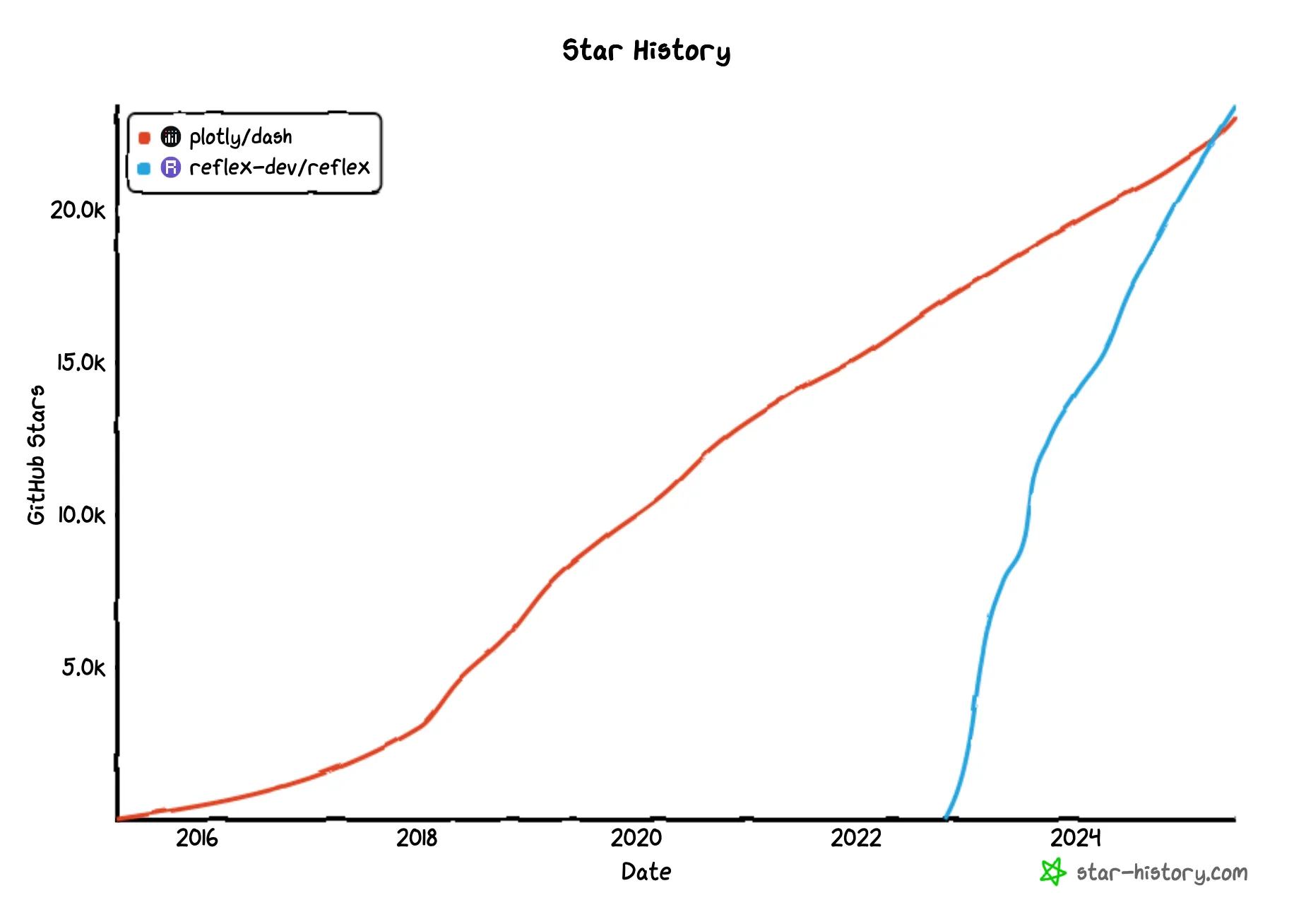Reflex vs Plotly Dash
A Comparison of Python Frameworks for Building Interactive Financial Dashboards
Tom Gotsman
·

Plotly Dash and Reflex are Python frameworks for building interactive data dashboards. Both enable data scientists and quantitative analysts in finance to create and deploy rich web-based financial dashboards without extensive web-development experience, though they take different approaches.
Below we will analyze the strengths and weaknesses of each framework across several dimensions:

Strengths
- End-to-end full-stack in Python - (backend + frontend generated; requires no JavaScript, HTML, or CSS)
- Declarative, state-driven model with automatic WebSocket sync - Developers define UI components and state variables in Python, and changes in state automatically propagate to the interface via WebSockets.
- Cleaner structure (state classes) - Real projects cut ~50 % code compared to Dash. This React-like state model means less manual wiring of interactions and often more concise code. More-structured code design (e.g., using Python classes for state) improves maintainability in practice.
Weaknesses
- Python-only stack - Limits adoption in mixed-language quant teams compared with Dash’s optional R/Julia bindings.
Strengths
- Pure-Python API - (with optional R/Julia bindings)
- Mature callback architecture built on Flask/React/Plotly.js - Dash uses a callback-based model on top of Flask—developers define Python functions as callbacks that tie UI inputs to outputs.
- Long-term stability and semantic-versioning upgrades
Weaknesses
- Stateless callbacks → extra boilerplate to preserve or share state
- Complex apps become “callback spaghetti” - Hard to organize in an object-oriented style. Large Dash apps can become callback-heavy—you may end up with many functions and global app state scattered around, since Dash lacks native support for object-oriented structuring of components/state.
- Responsive, multi-page UIs often need custom CSS/HTML know-how - Achieving highly responsive behavior (e.g., a fluid, multi-page UI) often requires writing extra boilerplate and understanding web fundamentals (responsiveness isn’t automatic).
Strengths
- 60+ built-in components with simple Python props for styling - Cover common needs from forms and panels to charts and data grids. These components come with modern default styling (so you get a polished look without manual CSS) and you can easily adjust their appearance or layout using Python attributes.
- Can wrap any custom React component - This means if a finance team needs a bespoke UI element (say a custom chart or control), they can integrate it into Reflex while still coding in Python.
- Has an official AG Grid integration - (Reflex AG Grid) for fast, Excel-like tables used in high-volume trade & P/L tables
Weaknesses
- Smaller third-party component ecosystem (still growing)
Strengths
- Rich core UI set and first-class Plotly charts (candles, yield curves…) - Dash comes with a robust set of core components (dropdowns, sliders, tables, etc.) and leverages Plotly’s powerful charting library for visuals.
- Large catalogue of community components & themes (Bootstrap, Material)
- Has an official AG Grid integration - (Dash AG Grid)
Weaknesses
- Complex styling/layout often demands raw CSS/HTML - Advanced UI tweaks often assume some web-development knowledge
- Visual polish relies on the developer - defaults feel dated versus modern JS stacks
Strengths
- Unified server-side state - (Python classes/vars) automatically pushes changes to the browser over WebSockets → instant updates for live P&L, tick data, or what-if sims
- Event-handler model - (write normal Python functions) avoids “callback spaghetti” and keeps code readable even with cascading filters or multi-tab apps
- Built-in sessions + auth - Allows each user’s state to be kept separate on the server, enabling multiple analysts to use the dashboard concurrently with their own data views or login-specific data (important for permissioned financial data)
- Efficient rendering - (Next.js/React) loads only needed components, so large dashboards stay snappy as they grow
Weaknesses
- Newer paradigm - Teams migrating from Dash must learn the state-driven pattern and keep pace with API evolution
Strengths
- Declarative callbacks - (Input → Output) are intuitive for simple drill-downs and have been battle-tested for years
- Fine-grained control of update logic can be useful for tightly scoped dashboards
Weaknesses
- Callbacks are stateless by default - persisting user choices or intermediate results needs hidden components or globals
- Complex apps accumulate hundreds of callbacks - This hurts readability and sometimes performance (“callback spaghetti”)
- No native server-push - True real-time feeds require polling intervals or custom WebSocket extensions
- Multi-user login/session management must be bolted on with extra libraries or reverse proxies
Strengths
- Simple deploy pipelines to Databricks, Snowflake, Azure, GCP, or AWS
- Async web server (Uvicorn/FastAPI under the hood) handles high-concurrency traffic - container-friendly and ASGI-compatible
- Ships with ORM, migrations, background jobs, file uploads, and role-based auth - fewer external services to wire up
- Built-in auth & RBAC - simplifies secure, multi-tenant finance dashboards
Weaknesses
- DevOps teams may craft CI/CD and observability pipelines themselves
Strengths
- Familiar Flask/W-SGI deploy pattern - Works on any server (Gunicorn, uWSGI) and all major clouds
- Dash Enterprise adds CI/CD, HTTPS, LDAP, and autoscaling for regulated environments
Weaknesses
- Workers are single-threaded during callbacks - must scale horizontally and load-balance
- Open-source package lacks built-in auth, background tasks, or ORM - extra libraries or reverse proxy required
Both Dash and Reflex are capable of producing high-quality, interactive financial dashboards, the best choice depends on your team’s priorities.
If you value a proven ecosystem and extensive community examples, or if your use case is relatively straightforward, Dash may be preferable. It excels in visualization and has years of user wisdom behind it.
On the other hand, if you need to build complex, bespoke analytics tools quickly and want to leverage Python for everything (from the database to the UI), Reflex can provide a faster development cycle and more out-of-the-box functionality. Its ability to handle heavy computations or data updates asynchronously in the background keeps the UI responsive even when crunching large datasets on the backend. It allows a small quant team to build a full production-grade dashboard app without waiting on front-end developers or learning web frameworks.
More Posts

Reflex x Databricks: Python-Powered Vibe Coding for Enterprises
We're excited to announce our official partnership with Databricks and the launch of our Reflex AI Builder integration with Databricks Apps.
Reflex Team

The 10 best internal tool builders in 2025
Reflex vs Retool vs Budibase vs Appsmith vs ToolJet vs Zapier Interfaces vs Glide vs Softr vs DronaHQ vs Microsoft Power Apps
Tom Gotsman

Top AI App Builders in 2025
Reflex.build vs Replit Agent vs v0.dev vs Bolt.new vs Lovable.dev
Tom Gotsman